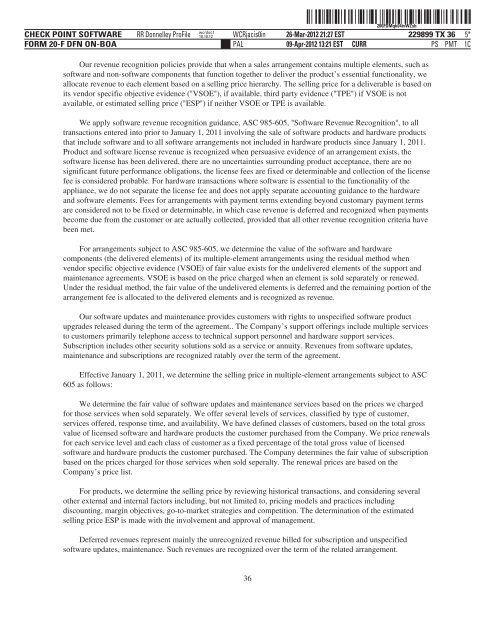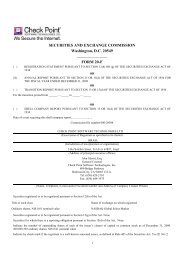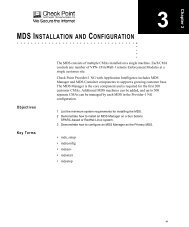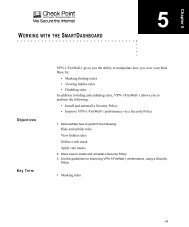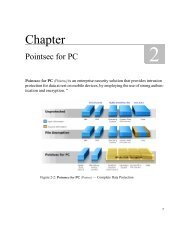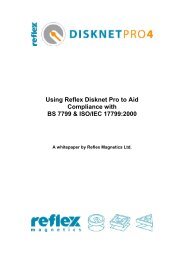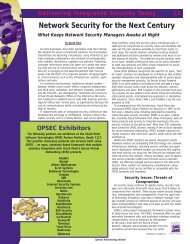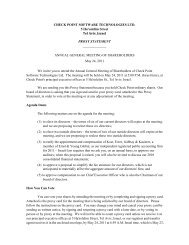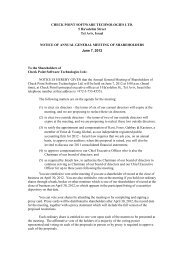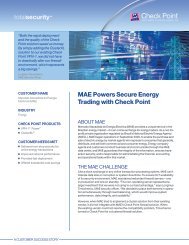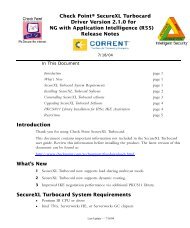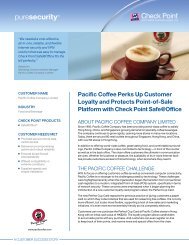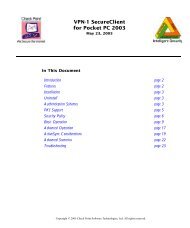printmgr file
printmgr file
printmgr file
Create successful ePaper yourself
Turn your PDF publications into a flip-book with our unique Google optimized e-Paper software.
CHECK POINT SOFTWARE<br />
FORM 20-F DFN ON-BOA<br />
ˆ200FDMqk04ivWZshHŠ<br />
200FDMqk04ivWZsh<br />
RR Donnelley ProFile wcrdoc1<br />
10.10.12 WCRjacis0in 26-Mar-2012 21:27 EST<br />
229899 TX 36 5*<br />
PAL<br />
09-Apr-2012 13:21 EST CURR<br />
PS PMT 1C<br />
Our revenue recognition policies provide that when a sales arrangement contains multiple elements, such as<br />
software and non-software components that function together to deliver the product’s essential functionality, we<br />
allocate revenue to each element based on a selling price hierarchy. The selling price for a deliverable is based on<br />
its vendor specific objective evidence ("VSOE"), if available, third party evidence ("TPE") if VSOE is not<br />
available, or estimated selling price ("ESP") if neither VSOE or TPE is available.<br />
We apply software revenue recognition guidance, ASC 985-605, "Software Revenue Recognition", to all<br />
transactions entered into prior to January 1, 2011 involving the sale of software products and hardware products<br />
that include software and to all software arrangements not included in hardware products since January 1, 2011.<br />
Product and software license revenue is recognized when persuasive evidence of an arrangement exists, the<br />
software license has been delivered, there are no uncertainties surrounding product acceptance, there are no<br />
significant future performance obligations, the license fees are fixed or determinable and collection of the license<br />
fee is considered probable. For hardware transactions where software is essential to the functionality of the<br />
appliance, we do not separate the license fee and does not apply separate accounting guidance to the hardware<br />
and software elements. Fees for arrangements with payment terms extending beyond customary payment terms<br />
are considered not to be fixed or determinable, in which case revenue is deferred and recognized when payments<br />
become due from the customer or are actually collected, provided that all other revenue recognition criteria have<br />
been met.<br />
For arrangements subject to ASC 985-605, we determine the value of the software and hardware<br />
components (the delivered elements) of its multiple-element arrangements using the residual method when<br />
vendor specific objective evidence (VSOE) of fair value exists for the undelivered elements of the support and<br />
maintenance agreements. VSOE is based on the price charged when an element is sold separately or renewed.<br />
Under the residual method, the fair value of the undelivered elements is deferred and the remaining portion of the<br />
arrangement fee is allocated to the delivered elements and is recognized as revenue.<br />
Our software updates and maintenance provides customers with rights to unspecified software product<br />
upgrades released during the term of the agreement.. The Company’s support offerings include multiple services<br />
to customers primarily telephone access to technical support personnel and hardware support services.<br />
Subscription includes other security solutions sold as a service or annuity. Revenues from software updates,<br />
maintenance and subscriptions are recognized ratably over the term of the agreement.<br />
Effective January 1, 2011, we determine the selling price in multiple-element arrangements subject to ASC<br />
605 as follows:<br />
We determine the fair value of software updates and maintenance services based on the prices we charged<br />
for those services when sold separately. We offer several levels of services, classified by type of customer,<br />
services offered, response time, and availability. We have defined classes of customers, based on the total gross<br />
value of licensed software and hardware products the customer purchased from the Company. We price renewals<br />
for each service level and each class of customer as a fixed percentage of the total gross value of licensed<br />
software and hardware products the customer purchased. The Company determines the fair value of subscription<br />
based on the prices charged for those services when sold seperalty. The renewal prices are based on the<br />
Company’s price list.<br />
For products, we determine the selling price by reviewing historical transactions, and considering several<br />
other external and internal factors including, but not limited to, pricing models and practices including<br />
discounting, margin objectives, go-to-market strategies and competition. The determination of the estimated<br />
selling price ESP is made with the involvement and approval of management.<br />
Deferred revenues represent mainly the unrecognized revenue billed for subscription and unspecified<br />
software updates, maintenance. Such revenues are recognized over the term of the related arrangement.<br />
36


